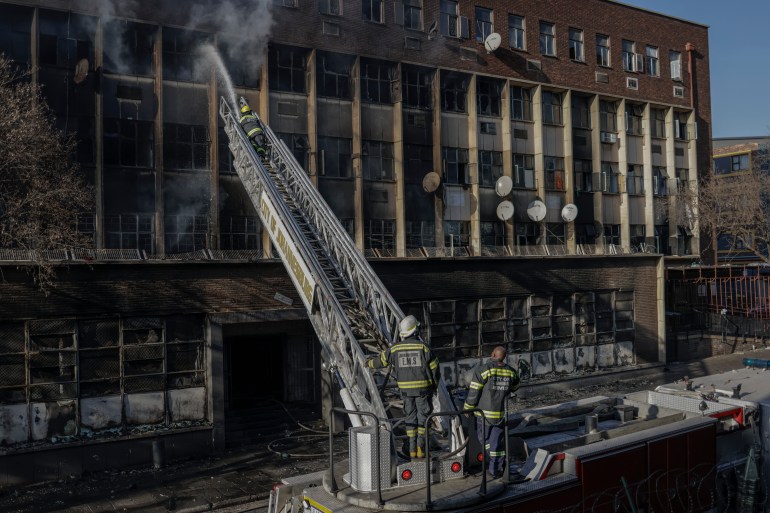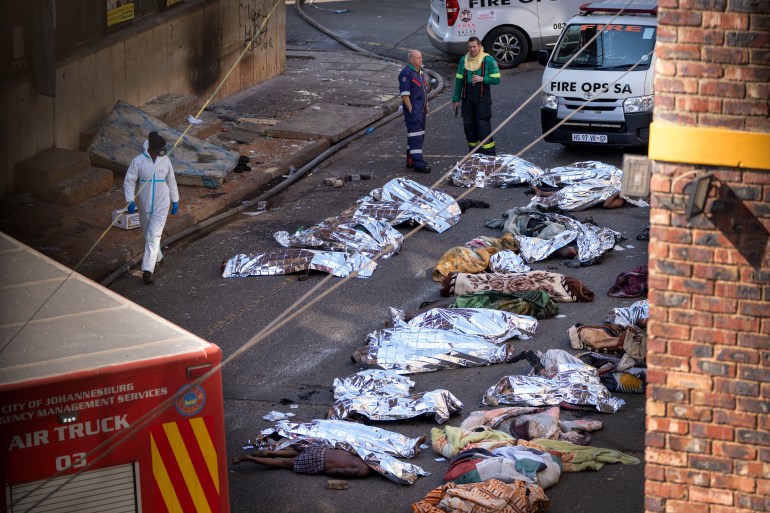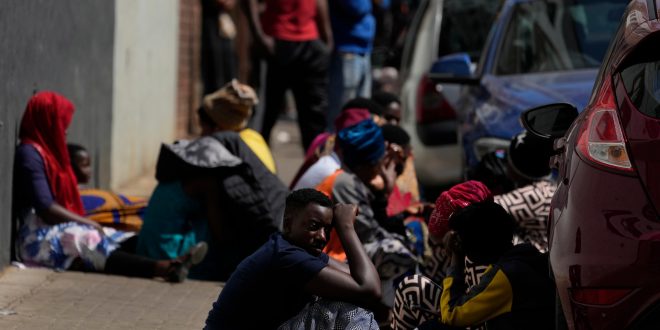Johannesburg, South Africa – Just hours after going to bed on Wednesday night, Adam Kamuweluze was woken in a frenzy in his small room on the third floor of a building in inner-city Johannesburg.
“Someone came running into our room and woke me and my brother up around 2am and said there is a fire coming from the first floor,” the 31-year-old recounted, standing outside the charred exterior of the building after firefighters had contained the blaze on Thursday.
Kamuweluze and his brother Freddy rushed to the exit as fast as they could. The building was filled with smoke and people bumping against each other; he remembers having to claw his way out. In the process, he lost track of Freddy.
Since escaping, Kamuweluze had been looking for his brother, waiting behind police tape to find out what happened to him.
Authorities said they got calls about a massive fire at a five-storey building in Johannesburg’s Marshalltown area about 1:30am on Thursday (23:30 GMT on Wednesday). By the evening, the death toll had risen to 74 while more than 50 people had been taken to nearby hospitals for injuries and smoke inhalation.
Witnesses at the scene said the building was overcrowded, there were dozens of rooms per floor and at least five people per room.
There was an “informal settlement” inside the building, Robert Mulaudzi, spokesperson for Johannesburg’s Emergency Management Services told the media. He said there were rows of “shacks” on each floor, which caused a delay in finding the bodies during the search and recovery operation.
The building’s main security gate was also closed, making it difficult for residents to escape, according to Mgcini Tshwaku, a member of Johannesburg’s mayoral committee in charge of public safety. “Many burned bodies were found stashed at that gate,” he told the media.

‘In the hands of cartels’
Across Johannesburg’s inner city are hundreds of buildings that lie derelict after being abandoned by their original owners, officials said. Many of them, like the one that burned, are then “hijacked” by crime syndicates or slumlords, who informally rent out rooms to people – many of them desperate, poor or foreign.
“There are cartels who prey on vulnerable people because some of these buildings, if not most of them, are actually in the hands of those cartels who collect rental from the people,” Lebogang Isaac Maile, the head of the Department of Human Settlements in Gauteng province, which includes Johannesburg, told reporters at the scene of the fire.
He said the blaze “demonstrates a chronic problem of housing in our province”.
Johannesburg, which is one of the world’s most unequal cities, has about 15,000 unhoused people, widespread poverty and joblessness.
Adam and Freddy Kamuweluze are Malawian immigrants who moved to South Africa in 2005 and work as informal street hawkers in the bustling inner city, where thousands of other migrants from across the continent have also made their home.
Residents of the burned building told Al Jazeera that it mostly housed Malawians and some Zimbabweans, Tanzanians and South Africans.
Although the cause of the fire is not yet known, emergency services said a candle or faulty electrical wiring could have started it.
Many “hijacked” buildings have no electricity, or if they do, the connections are often illegal and dangerous. Johannesburg also suffers from chronic power cuts, which leads many to resort to using candles for light and wood fires for heat.
‘Culpable homicide’
The burned building was originally known as Usindiso, the Socio-Economic Rights Institute (SERI), a South African human rights advocacy group, said in a statement. The building operated as a shelter for abused women and children until its neglect by the city government in 2018 which led to its state of disrepair, the NGO said.
“Unfortunately, the fire at the Usindiso shelter is an example of how the City deals with its shelters, which are occupied by many of Johannesburg’s poorest and most vulnerable residents. The conditions of the shelters and transitional housing need to be urgently improved and people living in them need access to basic services,” SERI said in a statement.
Former Mayor Herman Mashaba visited the site and described the incident as “culpable homicide” by the City of Johannesburg for neglecting the structure. He also lambasted SERI for stopping him from fixing the housing problem in the inner city during his term of office.
According to Mashaba, SERI would go to court to stop the city from giving derelict buildings to the private sector for redevelopment. SERI, which assists poor inner-city residents facing unlawful evictions, has called on municipalities to implement better housing plans that prevent buildings from being hijacked.
Kabelo Gwamanda, Johannesburg’s current mayor, visited the site with city officials on Thursday morning. He told reporters that the city is avoiding evictions of people living in hijacked buildings.
“As this current administration, we are taking a more prudent approach, and we are not going there with brute force. We are trying to apply the maximum sensitive strategy.”
Gwamanda said he has set up a mayoral committee to look into providing decent social housing for inner-city residents.

‘Some injured, some dead’
Witnesses and news media reported horrendous scenes in the early hours of Thursday as people on the building’s upper floors jumped out of windows to escape the flames.
At 6:30am (04:30 GMT), David De Beer, a meat seller at Impala Inn Butchery, located a street away from the burned building, arrived at work and saw bodies lying in the streets.
“There were a lot of people in the streets, some injured, some dead.”
De Beer told Al Jazeera that he avoids going down Albert Street towards the burned building because it is considered a dangerous area. According to the butcher, the Usindiso building used to be a clinic before it was taken over by criminal gangs that rent it cheaply to desperate migrants.
Denisiwe Ximba, a 27-year-old South African, found herself sitting on the pavement with her belongings after the fire. Denisiwe had just paid 1,000 South African rand ($53) for September’s rent at the Usindiso building.
She has been staying in Usindiso for two years since she moved to Johannesburg from the Eastern Cape in 2021 and supports herself by doing casual work, such as cleaning and hawking goods.
“The building was not all that safe. There were some muggings here and there,” Denisiwe told Al Jazeera. “But this fire has ruined everything. Where am I supposed to find a place to stay now?”
Maile told local media that a few buildings have been allocated for survivors of the fire to move into. But residents who lost everything are still waiting to hear news about their loved ones and about the next steps.
For many, the loss is more than just material. After hours spent looking for Freddy on Thursday, late in the afternoon, Adam Kamuweluze received news that left him devastated; his brother had died in hospital from smoke inhalation.
 Top Naija News: Nigerian News, Breaking News Nigeria and World News Top Naija News is a daily news publication in Nigeria, delivering the latest breaking news in Nigeria and around the world.
Top Naija News: Nigerian News, Breaking News Nigeria and World News Top Naija News is a daily news publication in Nigeria, delivering the latest breaking news in Nigeria and around the world.




